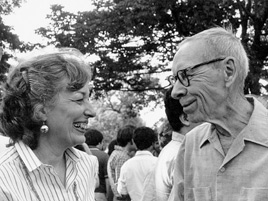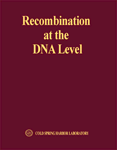|
XLIX: Recombination at the DNA Level 1984 |
|
|

|
From left: Dr. Anna Marie Skalka, Dr. Alfred Hershey SYMPOSIUM SYNOPSIS LIST OF PARTICIPANTS CONTENTS OF SYMPOSIUM VOLUME PHOTOGRAPHS PUBLISHED VOLUME  |
Recombination at the DNA Level
30 May - 6 June, 1984
Symposium Synopsis
Organizer: Amar J. S. Klar and Jeffrey N. Strathern
Advisors: Charles Radding, Nick Cozzarelli, Barbara McClintock, Bob Weisberg and Jim Watson.
The previous Symposium with “recombination” in the title had been held only six years before, and then recombination had formed the smaller part of the meeting that included also replication. Recombination had also been part of the Symposium on Movable Genetic Elements. Why was it felt that a third meeting was needed, three in the space of six years?
The main reason was that Frank Stahl’s prediction in his summary of the 1978 meeting had come true–the torch had passed from the geneticists to the biochemists. Moreover, recombinant DNA tools and techniques were now part and parcel of research and no longer restricted to a small coterie of laboratories. This meant that great science was being done by many more and this was reflected in the great diversity of the studies reported in this Symposium. Indeed, Alan Campbell in his summary commented on this diversity and would not predict whether common principles would ever emerge to unify recombination in all these systems.
A large number of studies used movable genetic elements as tools to analyze the integration of these DNA molecules as models for recombination at the chromosome scale. The bacterial transposons Tn5 and Tn10 were in evidence, as well as a set of papers reporting studies using the bacteriophage Mu. Research on Mu had been promoted by Ahmed Bukhari at Cold Spring Harbor Laboratory. Just a few months after the Symposium, and at the tragically young aged of 40, Bukhari died of a heart attack. The volume was dedicated to him.
A very interesting set of papers dealt with recombination in mammalian cells, between plasmids introduced into the cells, between two introduced plasmids, and a plasmid and sequences integrated into the chromosome. These studies led a few years later to practicable methods for manipulating genes in mammalian cells and, when applied to mouse embryonic stem cells, to the ability to change very precisely DNA sequences in a mouse.
Search images: